desanbenz
Sandesh Byanjankar
Monday, September 9, 2019
Tuesday, August 9, 2016
13 Amazing Facts About Linux That Will Surprise You
Check out these surprising facts about Linux and its comprehensive use today.
1. As Torvald began its project, the first Linux kernel occupied only 65 KB. Today, even a regular Linux kernel contains over 10 million lines of source codes.
2. Linux powers the New York Stock Exchange as well. Linux has surpassed the traditional Unix, thanks to its fast computing.
3. Linux kernel had more than 18 million lines of source code in its 3.18 version in 2015 and the rate of Linux development is unmatched. The improvements accepted into the Linux kernel per hour is 7.71, which sums to about 1,300 changes every week.
4. The Department of Defence of the US also uses Linux extensively. The Red Hat Linux runs the nuclear submarines of the State.
5. Linux is favored by the tech giants as well. For the web and cloud services, Linux is the first choice for Google, Amazon and Facebook.
6. You can run Microsoft Windows and the Linux kernel side by side on the same computer using a software called Cooperative Linux (coLinux).
7. The Scientific Linux controls the particle accelerator at CERN. It is based on Red Hat Linux and is again a free and open OS.
8. The bullet trains in Japan use Linux to maintain and manage the sophisticated Automatic Train Control system. Also, the In-Vehicle-Infotainment technology (IVI) inside Toyota and other automobiles use Linux platform.
9. The Linux kernel has expanded exponentially since it was first put out in the open source category. Today, Linus Torvalds’s codes account for only about 2% of the total codes in the kernel.
10. Out of top 500 fastest supercomputers of the world, Linux or its variants power 485 of those badass machines. No wonder Linux is termed as the king of super computing.
11. Wonder why the basic language taught in the schools is C? Because, a major chunk of the operating system kernels including Windows, Linux and Mac are written in C language. So, if you plan on becoming a developer, know the basics.
12. Even the best smartphones (Android, Maemo) are build on Linux kernel. You can also run your Ubuntu Phone in a windowed mode with slight tweaks. Here’s how to do it.
13. Linux has a special place in Hollywood as well. Visual effects of Titanic and Avatar were developed in 3D applications on Linux platform using FOSS software.
1. As Torvald began its project, the first Linux kernel occupied only 65 KB. Today, even a regular Linux kernel contains over 10 million lines of source codes.
2. Linux powers the New York Stock Exchange as well. Linux has surpassed the traditional Unix, thanks to its fast computing.
3. Linux kernel had more than 18 million lines of source code in its 3.18 version in 2015 and the rate of Linux development is unmatched. The improvements accepted into the Linux kernel per hour is 7.71, which sums to about 1,300 changes every week.
4. The Department of Defence of the US also uses Linux extensively. The Red Hat Linux runs the nuclear submarines of the State.
5. Linux is favored by the tech giants as well. For the web and cloud services, Linux is the first choice for Google, Amazon and Facebook.
6. You can run Microsoft Windows and the Linux kernel side by side on the same computer using a software called Cooperative Linux (coLinux).
7. The Scientific Linux controls the particle accelerator at CERN. It is based on Red Hat Linux and is again a free and open OS.
8. The bullet trains in Japan use Linux to maintain and manage the sophisticated Automatic Train Control system. Also, the In-Vehicle-Infotainment technology (IVI) inside Toyota and other automobiles use Linux platform.
9. The Linux kernel has expanded exponentially since it was first put out in the open source category. Today, Linus Torvalds’s codes account for only about 2% of the total codes in the kernel.
10. Out of top 500 fastest supercomputers of the world, Linux or its variants power 485 of those badass machines. No wonder Linux is termed as the king of super computing.
11. Wonder why the basic language taught in the schools is C? Because, a major chunk of the operating system kernels including Windows, Linux and Mac are written in C language. So, if you plan on becoming a developer, know the basics.
12. Even the best smartphones (Android, Maemo) are build on Linux kernel. You can also run your Ubuntu Phone in a windowed mode with slight tweaks. Here’s how to do it.
13. Linux has a special place in Hollywood as well. Visual effects of Titanic and Avatar were developed in 3D applications on Linux platform using FOSS software.
Linux Commands Cheat Sheet
A
apropos : Search Help manual pages (man -k)
apt-get : Search for and install software packages (Debian/Ubuntu)
aptitude : Search for and install software packages (Debian/Ubuntu)
aspell : Spell Checker
awk : Find and Replace text, database sort/validate/index
B
basename : Strip directory and suffix from filenames
bash : GNU Bourne-Again SHell
bc : Arbitrary precision calculator language
bg : Send to background
break : Exit from a loop
builtin : Run a shell builtin
bzip2 : Compress or decompress named file(s)
C
cal : Display a calendar
case : Conditionally perform a command
cat : Concatenate and print (display) the content of files
cd : Change Directory
cfdisk : Partition table manipulator for Linux
chgrp : Change group ownership
chmod : Change access permissions
chown : Change file owner and group
chroot : Run a command with a different root directory
chkconfig : System services (runlevel)
cksum : Print CRC checksum and byte counts
clear : Clear terminal screen
cmp : Compare two files
comm : Compare two sorted files line by line
command : Run a command – ignoring shell functions •
continue : Resume the next iteration of a loop •
cp : Copy one or more files to another location
cron : Daemon to execute scheduled commands
crontab : Schedule a command to run at a later time
csplit : Split a file into context-determined pieces
cut : Divide a file into several parts
D
date : Display or change the date & time
dc : Desk Calculator
dd : Convert and copy a file, write disk headers, boot records
ddrescue : Data recovery tool
declare : Declare variables and give them attributes •
df : Display free disk space
diff : Display the differences between two files
diff3 : Show differences among three files
dig : DNS lookup
dir : Briefly list directory contents
dircolors : Colour setup for `ls’
dirname : Convert a full pathname to just a path
dirs : Display list of remembered directories
dmesg : Print kernel & driver messages
du : Estimate file space usage
E
echo : Display message on screen •
egrep : Search file(s) for lines that match an extended expression
eject : Eject removable media
enable : Enable and disable builtin shell commands •
env : Environment variables
ethtool : Ethernet card settings
eval : Evaluate several commands/arguments
exec : Execute a command
exit : Exit the shell
expect : Automate arbitrary applications accessed over a terminal
expand : Convert tabs to spaces
export : Set an environment variable
expr : Evaluate expressions
F
false : Do nothing, unsuccessfully
fdformat : Low-level format a floppy disk
fdisk : Partition table manipulator for Linux
fg : Send job to foreground
fgrep : Search file(s) for lines that match a fixed string
file : Determine file type
find : Search for files that meet a desired criteria
fmt : Reformat paragraph text
fold : Wrap text to fit a specified width.
for : Expand words, and execute commands
format : Format disks or tapes
free : Display memory usage
fsck : File system consistency check and repair
ftp : File Transfer Protocol
function : Define Function Macros
fuser : Identify/kill the process that is accessing a file
G
gawk : Find and Replace text within file(s)
getopts : Parse positional parameters
grep : Search file(s) for lines that match a given pattern
groupadd : Add a user security group
groupdel : Delete a group
groupmod : Modify a group
groups : Print group names a user is in
gzip : Compress or decompress named file(s)
H
hash : Remember the full pathname of a name argument
head : Output the first part of file(s)
help : Display help for a built-in command
history : Command History
hostname : Print or set system name
I
iconv : Convert the character set of a file
id : Print user and group id’s
if : Conditionally perform a command
ifconfig : Configure a network interface
ifdown : Stop a network interface
ifup : Start a network interface up
import : Capture an X server screen and save the image to file
install : Copy files and set attributes
J
jobs : List active jobs
join : Join lines on a common field
K
kill : Stop a process from running
killall : Kill processes by name
L
less : Display output one screen at a time
let : Perform arithmetic on shell variables
ln : Create a symbolic link to a file
local : Create variables
locate : Find files
logname : Print current login name
logout : Exit a login shell
look : Display lines beginning with a given string
lpc : Line printer control program
lpr : Off line print
lprint : Print a file
lprintd : Abort a print job
lprintq : List the print queue
lprm : Remove jobs from the print queue
ls : List information about file(s)
lsof : List open files
M
make : Recompile a group of programs
man : Help manual
mkdir : Create new folder(s)
mkfifo : Make FIFOs (named pipes)
mkisofs : Create an hybrid ISO9660/JOLIET/HFS filesystem
mknod : Make block or character special files
more : Display output one screen at a time
mount : Mount a file system
mtools : Manipulate MS-DOS files
mtr : Network diagnostics (traceroute/ping)
mv : Move or rename files or directories
mmv : Mass Move and rename (files)
N
netstat : Networking information
nice Set : the priority of a command or job
nl Number : lines and write files
nohup : Run a command immune to hangups
notify-send : Send desktop notifications
nslookup : Query Internet name servers interactively
O
open : Open a file in its default application
op : Operator access
P
passwd : Modify a user password
paste : Merge lines of files
pathchk : Check file name portability
ping : Test a network connection
pkill : Stop processes from running
popd : Restore the previous value of the current directory
pr : Prepare files for printing
printcap : Printer capability database
printenv : Print environment variables
printf : Format and print data •
ps : Process status
pushd : Save and then change the current directory
pwd : Print Working Directory
Q
quota : Display disk usage and limits
quotacheck : Scan a file system for disk usage
quotactl : Set disk quotas
R
ram : ram disk device
rcp : Copy files between two machines
read : Read a line from standard input
readarray : Read from stdin into an array variable
readonly : Mark variables/functions as readonly
reboot : Reboot the system
rename : Rename files
renice : Alter priority of running processes
remsync : Synchronize remote files via email
return : Exit a shell function
rev : Reverse lines of a file
rm : Remove files
rmdir : Remove folder(s)
rsync : Remote file copy (Synchronize file trees)
S
screen : Multiplex terminal, run remote shells via ssh
scp : Secure copy (remote file copy)
sdiff : Merge two files interactively
sed : Stream Editor
select : Accept keyboard input
seq : Print numeric sequences
set: Manipulate shell variables and functions
sftp : Secure File Transfer Program
shift : Shift positional parameters
shopt : Shell Options
shutdown : Shutdown or restart linux
sleep : Delay for a specified time
slocate : Find files
sort : Sort text files
source : Run commands from a file `.’
split : Split a file into fixed-size pieces
ssh : Secure Shell client (remote login program)
strace : Trace system calls and signals
su : Substitute user identity
sudo : Execute a command as another user
sum : Print a checksum for a file
suspend : Suspend execution of this shell
symlink : Make a new name for a file
sync : Synchronize data on disk with memory
T
tail : Output the last part of file
tar : Tape ARchiver
tee : Redirect output to multiple files
test : Evaluate a conditional expression
time : Measure Program running time
times : User and system times
touch : Change file timestamps
top : List processes running on the system
traceroute : Trace Route to Host
trap : Run a command when a signal is set(bourne)
tr : Translate, squeeze, and/or delete characters
true : Do nothing, successfully
tsort : Topological sort
tty : Print filename of terminal on stdin
type : Describe a command
U
ulimit : Limit user resources
umask : Users file creation mask
umount : Unmount a device
unalias : Remove an alias
uname : Print system information
unexpand : Convert spaces to tabs
uniq : Uniquify files
units : Convert units from one scale to another
unset : Remove variable or function names
unshar : Unpack shell archive scripts
until : Execute commands (until error)
uptime : Show uptime
useradd : Create new user account
userdel : Delete a user account
usermod : Modify user account
users : List users currently logged in
uuencode : Encode a binary file
uudecode : Decode a file created by uuencode
V
v : Verbosely list directory contents (`ls -l -b’)
vdir : Verbosely list directory contents (`ls -l -b’)
vi : Text Editor
vmstat : Report virtual memory statistics
W
wait : Wait for a process to complete
watch : Execute/display a program periodically
wc : Print byte, word, and line counts
whereis : Search the user’s $path, man pages and source files for a program
which : Search the user’s $path for a program file
while : Execute commands
who : Print all usernames currently logged in
whoami : Print the current user id and name (`id -un’)
wget : Retrieve web pages or files via HTTP, HTTPS or FTP
write : Send a message to another user
x
xargs : Execute utility, passing constructed argument list(s)
xdg-open : Open a file or URL in the user’s preferred application
apropos : Search Help manual pages (man -k)
apt-get : Search for and install software packages (Debian/Ubuntu)
aptitude : Search for and install software packages (Debian/Ubuntu)
aspell : Spell Checker
awk : Find and Replace text, database sort/validate/index
B
basename : Strip directory and suffix from filenames
bash : GNU Bourne-Again SHell
bc : Arbitrary precision calculator language
bg : Send to background
break : Exit from a loop
builtin : Run a shell builtin
bzip2 : Compress or decompress named file(s)
C
cal : Display a calendar
case : Conditionally perform a command
cat : Concatenate and print (display) the content of files
cd : Change Directory
cfdisk : Partition table manipulator for Linux
chgrp : Change group ownership
chmod : Change access permissions
chown : Change file owner and group
chroot : Run a command with a different root directory
chkconfig : System services (runlevel)
cksum : Print CRC checksum and byte counts
clear : Clear terminal screen
cmp : Compare two files
comm : Compare two sorted files line by line
command : Run a command – ignoring shell functions •
continue : Resume the next iteration of a loop •
cp : Copy one or more files to another location
cron : Daemon to execute scheduled commands
crontab : Schedule a command to run at a later time
csplit : Split a file into context-determined pieces
cut : Divide a file into several parts
D
date : Display or change the date & time
dc : Desk Calculator
dd : Convert and copy a file, write disk headers, boot records
ddrescue : Data recovery tool
declare : Declare variables and give them attributes •
df : Display free disk space
diff : Display the differences between two files
diff3 : Show differences among three files
dig : DNS lookup
dir : Briefly list directory contents
dircolors : Colour setup for `ls’
dirname : Convert a full pathname to just a path
dirs : Display list of remembered directories
dmesg : Print kernel & driver messages
du : Estimate file space usage
E
echo : Display message on screen •
egrep : Search file(s) for lines that match an extended expression
eject : Eject removable media
enable : Enable and disable builtin shell commands •
env : Environment variables
ethtool : Ethernet card settings
eval : Evaluate several commands/arguments
exec : Execute a command
exit : Exit the shell
expect : Automate arbitrary applications accessed over a terminal
expand : Convert tabs to spaces
export : Set an environment variable
expr : Evaluate expressions
F
false : Do nothing, unsuccessfully
fdformat : Low-level format a floppy disk
fdisk : Partition table manipulator for Linux
fg : Send job to foreground
fgrep : Search file(s) for lines that match a fixed string
file : Determine file type
find : Search for files that meet a desired criteria
fmt : Reformat paragraph text
fold : Wrap text to fit a specified width.
for : Expand words, and execute commands
format : Format disks or tapes
free : Display memory usage
fsck : File system consistency check and repair
ftp : File Transfer Protocol
function : Define Function Macros
fuser : Identify/kill the process that is accessing a file
G
gawk : Find and Replace text within file(s)
getopts : Parse positional parameters
grep : Search file(s) for lines that match a given pattern
groupadd : Add a user security group
groupdel : Delete a group
groupmod : Modify a group
groups : Print group names a user is in
gzip : Compress or decompress named file(s)
H
hash : Remember the full pathname of a name argument
head : Output the first part of file(s)
help : Display help for a built-in command
history : Command History
hostname : Print or set system name
I
iconv : Convert the character set of a file
id : Print user and group id’s
if : Conditionally perform a command
ifconfig : Configure a network interface
ifdown : Stop a network interface
ifup : Start a network interface up
import : Capture an X server screen and save the image to file
install : Copy files and set attributes
J
jobs : List active jobs
join : Join lines on a common field
K
kill : Stop a process from running
killall : Kill processes by name
L
less : Display output one screen at a time
let : Perform arithmetic on shell variables
ln : Create a symbolic link to a file
local : Create variables
locate : Find files
logname : Print current login name
logout : Exit a login shell
look : Display lines beginning with a given string
lpc : Line printer control program
lpr : Off line print
lprint : Print a file
lprintd : Abort a print job
lprintq : List the print queue
lprm : Remove jobs from the print queue
ls : List information about file(s)
lsof : List open files
M
make : Recompile a group of programs
man : Help manual
mkdir : Create new folder(s)
mkfifo : Make FIFOs (named pipes)
mkisofs : Create an hybrid ISO9660/JOLIET/HFS filesystem
mknod : Make block or character special files
more : Display output one screen at a time
mount : Mount a file system
mtools : Manipulate MS-DOS files
mtr : Network diagnostics (traceroute/ping)
mv : Move or rename files or directories
mmv : Mass Move and rename (files)
N
netstat : Networking information
nice Set : the priority of a command or job
nl Number : lines and write files
nohup : Run a command immune to hangups
notify-send : Send desktop notifications
nslookup : Query Internet name servers interactively
O
open : Open a file in its default application
op : Operator access
P
passwd : Modify a user password
paste : Merge lines of files
pathchk : Check file name portability
ping : Test a network connection
pkill : Stop processes from running
popd : Restore the previous value of the current directory
pr : Prepare files for printing
printcap : Printer capability database
printenv : Print environment variables
printf : Format and print data •
ps : Process status
pushd : Save and then change the current directory
pwd : Print Working Directory
Q
quota : Display disk usage and limits
quotacheck : Scan a file system for disk usage
quotactl : Set disk quotas
R
ram : ram disk device
rcp : Copy files between two machines
read : Read a line from standard input
readarray : Read from stdin into an array variable
readonly : Mark variables/functions as readonly
reboot : Reboot the system
rename : Rename files
renice : Alter priority of running processes
remsync : Synchronize remote files via email
return : Exit a shell function
rev : Reverse lines of a file
rm : Remove files
rmdir : Remove folder(s)
rsync : Remote file copy (Synchronize file trees)
S
screen : Multiplex terminal, run remote shells via ssh
scp : Secure copy (remote file copy)
sdiff : Merge two files interactively
sed : Stream Editor
select : Accept keyboard input
seq : Print numeric sequences
set: Manipulate shell variables and functions
sftp : Secure File Transfer Program
shift : Shift positional parameters
shopt : Shell Options
shutdown : Shutdown or restart linux
sleep : Delay for a specified time
slocate : Find files
sort : Sort text files
source : Run commands from a file `.’
split : Split a file into fixed-size pieces
ssh : Secure Shell client (remote login program)
strace : Trace system calls and signals
su : Substitute user identity
sudo : Execute a command as another user
sum : Print a checksum for a file
suspend : Suspend execution of this shell
symlink : Make a new name for a file
sync : Synchronize data on disk with memory
T
tail : Output the last part of file
tar : Tape ARchiver
tee : Redirect output to multiple files
test : Evaluate a conditional expression
time : Measure Program running time
times : User and system times
touch : Change file timestamps
top : List processes running on the system
traceroute : Trace Route to Host
trap : Run a command when a signal is set(bourne)
tr : Translate, squeeze, and/or delete characters
true : Do nothing, successfully
tsort : Topological sort
tty : Print filename of terminal on stdin
type : Describe a command
U
ulimit : Limit user resources
umask : Users file creation mask
umount : Unmount a device
unalias : Remove an alias
uname : Print system information
unexpand : Convert spaces to tabs
uniq : Uniquify files
units : Convert units from one scale to another
unset : Remove variable or function names
unshar : Unpack shell archive scripts
until : Execute commands (until error)
uptime : Show uptime
useradd : Create new user account
userdel : Delete a user account
usermod : Modify user account
users : List users currently logged in
uuencode : Encode a binary file
uudecode : Decode a file created by uuencode
V
v : Verbosely list directory contents (`ls -l -b’)
vdir : Verbosely list directory contents (`ls -l -b’)
vi : Text Editor
vmstat : Report virtual memory statistics
W
wait : Wait for a process to complete
watch : Execute/display a program periodically
wc : Print byte, word, and line counts
whereis : Search the user’s $path, man pages and source files for a program
which : Search the user’s $path for a program file
while : Execute commands
who : Print all usernames currently logged in
whoami : Print the current user id and name (`id -un’)
wget : Retrieve web pages or files via HTTP, HTTPS or FTP
write : Send a message to another user
x
xargs : Execute utility, passing constructed argument list(s)
xdg-open : Open a file or URL in the user’s preferred application
MYSQL Cheat Sheet Free Download
Download CheatSheet for MYSQL
MySQL Data Types
CHAR String (0 - 255) VARCHAR String (0 - 255) TINYTEXT String (0 - 255) TEXT String (0 - 65535) BLOB String (0 - 65535) MEDIUMTEXT String (0 - 16777215) MEDIUMBLOB String (0 - 16777215) LONGTEXT String (0 - 4294967295) LONGBLOB String (0 - 4294967295) TINYINT x Integer (-128 to 127) SMALLINT x Integer(-32768 to 32767) MEDIUMINT x Integer (-8388608 to 8388607) INT x Integer (-2147483648 to 2147483647) BIGINT x Integer (-9223372036854775808 to 9223372036854775807) FLOAT Decimal (precise to 23 digits) DOUBLE Decimal (24 to 53 digits) DECIMAL "DOUBLE" stored as string DATE YYYY-MM-DD DATETIME YYYY-MM-DD HH:MM:SS TIMESTAMP YYYYMMDDHHMMSS TIME HH:MM:SS ENUM One of preset options SET Selection of preset options
MySQL Mathematical Functions
ABS COS SIGN SIN MOD TAN FLOOR ACOS CEILING ASIN ROUND ATAN, ATAN2 DIV COT EXP RAND LN LEAST LOG, LOG2, LOG10 GREATEST POW DEGREES POWER RADIANS SQRT TRUNCATE PI
MySQL Date and Time Functions
DAYOFWEEK DATE_SUB WEEKDAY ADDDATE DAYOFMONTH SUBDATE DAYOFYEAR EXTRACT MONTH TO_DAYS DAYNAME FROM_DAYS MONTHNAME DATE_FORMAT QUARTER TIME_FORMAT WEEK CURRENT_DATE YEAR CURRENT_TIME YEARWEEK NOW HOUR SYSDATE MINUTE UNIX_TIMESTAMP SECOND FROM_UNIXTIME PERIOD_ADD SEC_TO_TIME PERIOD_DIFF TIME_TO_SEC DATE_ADD
MySQL Miscellaneous Functions
BIT_COUNT DES_ENCRYPT DATABASE DES_DECRYPT USER LAST _ INSERT_ID SYSTEM_USE FORMAT SESSION_USER VERSION CURRENT_USER CONNECTION_ID PASSWORD GET_LOCK OLD_PASSWORD RELEASE_LOCK ENCRYPT IS_FREE_LOCK DECODE BENCHMARK MD5 INET_NTOA SHA1 INET_ATON AES_ENCRYPT FOUND_ROWS AES_DECRYPT STRCMP
MySQL String Functions
ASCII SUBSTRING
ORD MID
CONV SUBSTRING_INDEX
BIN LTRIM
OCT RTRIM
HEX TRIM
CHAR SOUNDEX
CONCAT SPACE
CONCAT_WS REPLACE
LENGTH REPEAT
CHAR_LENGTH REVERSE
BIT_LENGTH INSERT
LOCATE ELT
INSTR FIELD
LPAD LCASE
RPAD UCASE
LEFT LOAD _FILE
RIGHT QUOTE
MySQL Grouping Functions
AVG MAX BIT_AND STD BIT_OR STDDEV COUNT SUM GROUP_CONCAT VARIANCE MIN
Friday, August 5, 2016
How To Backup Contacts In Android Phone. ?
Android mobiles are popular in market because Android offer you the amazing features in cheaper rates. Android is based on Linux based Operating System and hardware independent. Android smartphones include features like high quality camera, touch support, Fast 3G, 4G and so on internet speed connections, RAM, ROM, processor with many other features which makes Android a best class smartphone. Android is popular for its Apps and games marketplace. As normally use Google play store which offer a large number of Apps, games, ebooks at free and paid version.
As Android OS is an Google Inc Product. So Google provide all the features which need other services like playstore, drives, maps music and many more. To store huge amount data and keep them secure We need to create backup our all data safely. Google also provides Sync features to drive or gmail account for backups but we need high speed internet connection to do that. As the most important data of our phone is contact. So always to make backup of all of them. In case our Android device is lost or sometimes our Android device is accidentally format by someone. If you don’t have internet to sync then we have to backup contacts in android on some other storage device so that we can take backup in case of any emergency. If you do not know how to backup contacts in android phone then don’t worry because today we are going to discuss some best methods to take backup all contacts in Android device. So that you can easily recover them whenever you want.
As Android OS is an Google Inc Product. So Google provide all the features which need other services like playstore, drives, maps music and many more. To store huge amount data and keep them secure We need to create backup our all data safely. Google also provides Sync features to drive or gmail account for backups but we need high speed internet connection to do that. As the most important data of our phone is contact. So always to make backup of all of them. In case our Android device is lost or sometimes our Android device is accidentally format by someone. If you don’t have internet to sync then we have to backup contacts in android on some other storage device so that we can take backup in case of any emergency. If you do not know how to backup contacts in android phone then don’t worry because today we are going to discuss some best methods to take backup all contacts in Android device. So that you can easily recover them whenever you want.
How To Backup Contacts In Android Phone. ?
Method 1st:- Backup Android Contact To SD Card.
Contact App is an inbuilt Android app that comes with every Android device. It is used to manage contacts on our Android device, saved new contacts and allow to take backup of contacts into SD card or sim Card. We can transfer these contacts into PC or some other device.
Steps To Backup Contacts In Android.
1. Open your Android device menu and click on contact App.
2. Click the Tap button now you see a popup Menu.
3. In the menu tap import/export menu item.
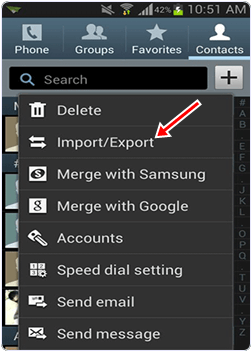
4. Now you see import/export popup menu. In the menu select export to external storage.
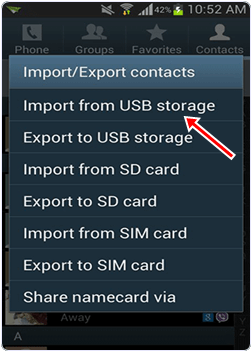
5. In this way you can backup your Android contacts to SD card. The backup contacts are stored in VCard file in the SD card.
6. Now you can connect your phone with PC using Wifi and USB cable and Drag and Drop your contacts to PC or Laptop.
2. Click the Tap button now you see a popup Menu.
3. In the menu tap import/export menu item.

4. Now you see import/export popup menu. In the menu select export to external storage.

5. In this way you can backup your Android contacts to SD card. The backup contacts are stored in VCard file in the SD card.
6. Now you can connect your phone with PC using Wifi and USB cable and Drag and Drop your contacts to PC or Laptop.
Method 2nd:- Backup Contacts From Android To Gmail.
You can also backup your Android phone contacts on your gmail Account by using the following simple steps.
Steps to Backup all contacts.
1. Open your Android menu and finds settings. You can also open setting by home screen drop down menu.
2. In the settings click on the scroll button to find Account and sync.
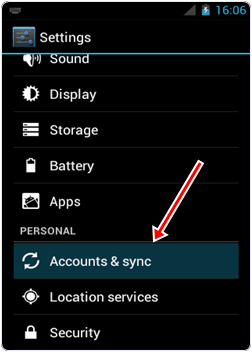
3. After that Login to your Gmail Account and tap sync contact option. It will take few minutes.
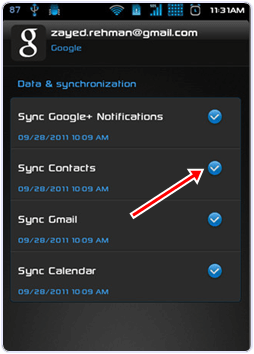
4. If you already save your contacts to your gmail Account, then you need not to follow first to steps and then directly login to your Account. Please open your Gmail on PC.
5. Select the contacts you want to backup and click more button then select export button.
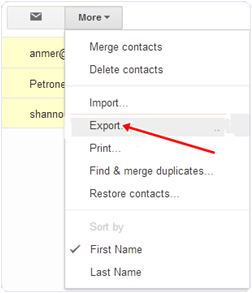
6. Choose the selected contact radio button and select the vcard format then you can save your contact to PC. You can open them in the Address book.
1. Open your Android menu and finds settings. You can also open setting by home screen drop down menu.
2. In the settings click on the scroll button to find Account and sync.

3. After that Login to your Gmail Account and tap sync contact option. It will take few minutes.

4. If you already save your contacts to your gmail Account, then you need not to follow first to steps and then directly login to your Account. Please open your Gmail on PC.
5. Select the contacts you want to backup and click more button then select export button.

6. Choose the selected contact radio button and select the vcard format then you can save your contact to PC. You can open them in the Address book.
Method 3rd:- Backup Contact s From Android To PC.
MobileGo is an efficient Application for sharing Android device data with computers. We can transfer data to and from Android to computer and vice versa. The app is available for both Windows and Mac OS. It allow you to take backup of your contacts just with one click.
Steps to Backup Contacts In Android.
1. Download and Install MobileGo Wondershare App in you PC. Run the App.
2. Connect your Android device with WiFi or via a USB cable. Software will Automatically detect your Android device and show in the primary Window.
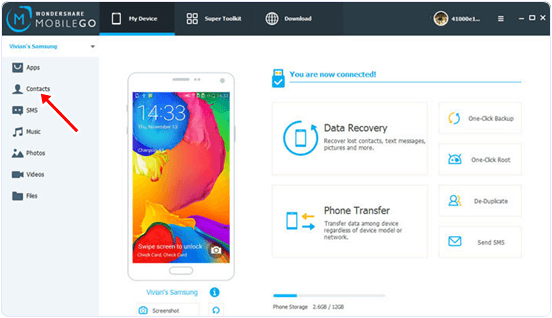
3. Now click on the contact tab to open the contact management Window.
4. In the contact management Window you see a list of your phone contacts.
5. Select the contacts and click on import/export button.
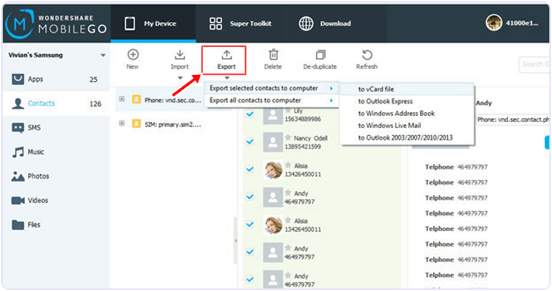
6. Now see a drop down menu. In the menu select export selected contacts to computer or export all contacts to computer.
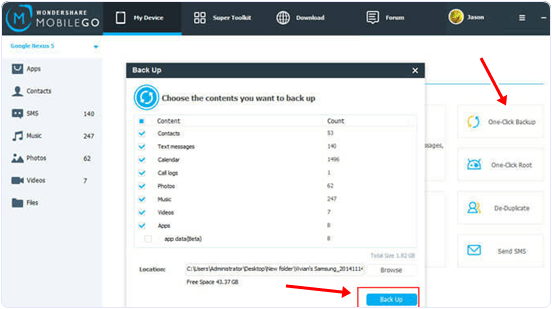
2. Connect your Android device with WiFi or via a USB cable. Software will Automatically detect your Android device and show in the primary Window.

3. Now click on the contact tab to open the contact management Window.
4. In the contact management Window you see a list of your phone contacts.
5. Select the contacts and click on import/export button.

6. Now see a drop down menu. In the menu select export selected contacts to computer or export all contacts to computer.

7. Now your contact list is ready and you can view it using Outlook Express, Window address book etc in vCard file.So these are some best ways to backup all contacts on android smartphone easily. If you know any other method don’t forget to share it with us in comments.
How To Hide Apps On Android Phone
Android phones are become a necessary part of life. We use Android mobiles in our day to day life for many different purposes. We can perform various task according to different occasions. As usually we access internet, share files, play videos and Audio, Messages and access many other internal phone features. In android device we can download external apps and games from marketplace. Because of these flexibilities and availability of these features at low cost, that’s why Android devices are so popular. Android phones provide large storage in which we can install Apps, games and save our data. Android phones are assumed to be personal because they hold our personal App and data which we do not share with others. Normally we use screen lockers which protect our phone from misuse. If you are not using yet then i recommend you to check out best screen lock apps for android.
But in some situations we have to share our phone with our friends and relatives. But we also don’t want to share personal information and Apps with them. Sometime children wants to play games on android. As by mistake even they can format data or other details then backups should be necessary also. I have listed our best backup and restore apps for android. So to maintain our phone privacy one easiest way is by hiding apps. If you are facing serious problem regarding data security and privacy then you can try some data hiding apps. So without worry about security you can manage others for accessing your device. So here i am going to discuss about some best method to hide apps on android phone.
How To Hide Apps On Android Phone.
But in some situations we have to share our phone with our friends and relatives. But we also don’t want to share personal information and Apps with them. Sometime children wants to play games on android. As by mistake even they can format data or other details then backups should be necessary also. I have listed our best backup and restore apps for android. So to maintain our phone privacy one easiest way is by hiding apps. If you are facing serious problem regarding data security and privacy then you can try some data hiding apps. So without worry about security you can manage others for accessing your device. So here i am going to discuss about some best method to hide apps on android phone.
How To Hide Apps On Android Phone.
Method 1. Using GO Launcher Ex (For Non Rooted Phone).
Steps To Hide Apps In Android Using GO Launcher EX.
Step 1. Open your Playstore Account from your Android Phone and Search GO Launcher.
Step 2. You need to scan for the QR code to install this App.
Step 2. You need to scan for the QR code to install this App.
Step 3. Your Android Phone will Automatically search for GO Launcher App even if you do not have QR code scanner in your phone.
Step 4. Now install the GO launcher App in your phone.
Step 5. After the installation you have to apply GO Launcher to your Android device.
Step 6. Click and launch the App and by opening the main menu you can see different installed App in your App.
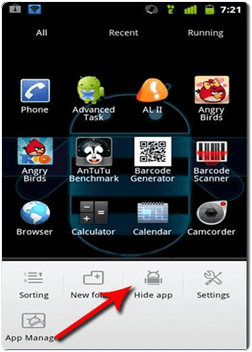
Step 7. You can also go through the different option of the App by tapping the Menu button. From menu you look the Hide App option.
Step 8. A list of App will be shown on your screen.
Step 9. Now tick the Apps you want to hide and click the OK button.
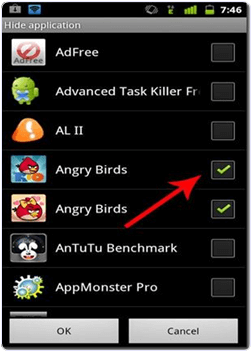
Step 10. Now selected Apps will be hidden from your menu.
Step 4. Now install the GO launcher App in your phone.
Step 5. After the installation you have to apply GO Launcher to your Android device.
Step 6. Click and launch the App and by opening the main menu you can see different installed App in your App.

Step 7. You can also go through the different option of the App by tapping the Menu button. From menu you look the Hide App option.
Step 8. A list of App will be shown on your screen.
Step 9. Now tick the Apps you want to hide and click the OK button.

Step 10. Now selected Apps will be hidden from your menu.
Method 2:- Using Link2SD Android App (for Rooted Phones).
Steps To Hide Android Apps With Link2SD.
Step 1. Download and Install the Link2SD Android App by clicking the button below.
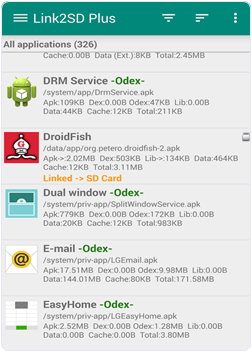
Step 3. You can go through different Apps option at least once to understand its different options.
Step 4. In the App you will see all installed Apps.
Step 5. Click on the menu button and look for frozen option.
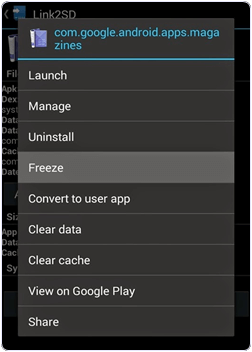
Step 6. You will see the Apps now select the Apps and press OK button.
Step 7. Now your Apps are completely hidden and to unhidden the App long press the desired App and select unfreeze option.
These are best ways to hide apps on android phone. In you face any problem or you know any other easy and best method to hide apps on android mobile. Don’t forget to share it with us in comments.
Monday, July 4, 2016
How to run iPhone and iPad apps on your PC/laptop
iPadian 3.0 is the Windows Software thru which you can make your Computer / desktop feels like Apple interface.
You can download it from here .
DOWNLOAD.
Specification: iPadian 3.0:
Platforms:Windows XP,Windows Vista (32 bit),Windows 7 (32 bit),Windows Vista (64 bit),Windows 7 (64 bit),Windows 8
Version:0.1
Licence:Freeware
Developer:iPadian
Date Added:04 July 16
You can download it from here .
DOWNLOAD.
Specification: iPadian 3.0:
Platforms:Windows XP,Windows Vista (32 bit),Windows 7 (32 bit),Windows Vista (64 bit),Windows 7 (64 bit),Windows 8
Version:0.1
Licence:Freeware
Developer:iPadian
Date Added:04 July 16
Monday, June 13, 2016
Thursday, June 2, 2016
Best Hidden iPhone Secret Codes 2016
*#06#
It will displays your iPhone IMEI. It is a identifier for your mobile phone hardware.
*3001#12345#*
This code opens you field mode which contains all of iPhone inner settings, cell information and newest network.
*#67#
You can check the number in order to call forwarding when the iPhone is busy. And again, but for when the iPhone is busy.
*646# (Postpaid only)
It will display you available minutes.
*225# ( Postpaid only)
To check the Bill Balance
*777#
To check the Account balance use this code for prepaid iPhone only.
*#33#
You can check call control bars by using this code. Also for see whether barring is enabled or disabled for outgoing you can check all the usual suspects like fax, SMS, voice, information, etc.
*#76#
For checking connected line presentation is enabled or not you can use this code. like to the calling line presentation you can also check whether the connected line presentation is enabled or disabled.
*#21#
You can set inquiry for call forwards. Find the settings for your call forwarding. You will see whether you have fax, SMS, voice, knowledge, sync, async, paid access & packet access call forwarding enabled or disabled.
*3282#
It will let you know about the use of information info.
*#61#
To check number of missed calls.
*#62#
You can verifies the number for forwarding calls If there is no service is available. .
*3370#
EFR mode Enhanced Full Rate improves your iPhone voice quality, but it will slightly reduced battery life.
*#5005*7672#
To check SMS center.
*331*
Barring code # Outgoing calls abroad to block the lock code to inquire about her please contact your network operator.
*#43#
Call Waiting Status.
*43#
Activate a waiting.
#43#
Deactivate waiting.
*#31#
It allow you hide your number.
Subscribe to:
Comments (Atom)


